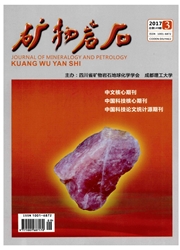

 中文摘要:
中文摘要:
利用X射线衍射和X射线荧光分析、沉积物序列提取试验及矿物饱和度的计算,对采自江汉平原中部沙湖地区典型高砷含水层钻孔沉积物样品矿物学进行了分析,并讨论了控制含水层中砷释放和迁移的地球化学机制。对矿物在沉积物与土壤中的分布及组成的对比分析,在一定程度上指示了矿物赋存环境和/或高砷水形成的环境背景:土壤与沉积物中高岭石以低于其他3种粘土矿物的含量普遍存在,指示了含水层沉积物形成过程江汉平原存在一定的湿热古气候环境;沉积物绿泥石含量低于土壤中绿泥石,恰恰反映了土壤比沉积物略强的碱性环境;沉积物中黄铁矿的存在,显示了含水层局部的强还原性环境,指示地下水中广泛存在的Fe2+容易与二价硫发生沉淀并结合砷。砷主要以无定形铁锰氧化物结合态(平均在31%以上)形式存在,其次以碳酸盐和有机质结合态存在。无定形铁锰氧化物的还原溶解可能是控制砷迁移到地下水中主要的地球化学机制。相对高含量的绿泥石容易在含水层中发生风化,其溶解过程可以将铁释放到地下水中,从而成为影响地下水中砷活化的潜在因素。
 英文摘要:
英文摘要:
Analysis of XRD and XRF, combined with sequential extraction experiment o{ sedi- ments and saturation index calculation were conducted to understand the mechanism of arsenic re- lease from sediments into groundwater. The difference in mineral composition distribution and characteristics between soil and sediments revealed the occurrence environment of minerals and the conditions for the formation of elevated arsenic groundwater. Detected pyrite reflected the re- ducing environment of aquifer. Arsenic bond to amorphous iron oxyhydroxides was the main spe- cies occurred in sediments. The reductive dissolution o{ iron oxyhydroxides was considered as the main geochemical mechanism responsible for arsenic mobilization. Chlorite was also a potential species associated with arsenic mobilization due to iron dissolution/release.
 同期刊论文项目
同期刊论文项目
 同项目期刊论文
同项目期刊论文
 Photodegradation of azithromycin in various aqueous systems under simulated and natural solar radiat
Photodegradation of azithromycin in various aqueous systems under simulated and natural solar radiat Headspace Solid-Phase Microextraction (HS-SPME) and Solid-Phase Extraction (SPE) Concentration for Q
Headspace Solid-Phase Microextraction (HS-SPME) and Solid-Phase Extraction (SPE) Concentration for Q Pathways for the steroidal saponins conversion to diosgenin during acid hydrolysis of Dioscorea zing
Pathways for the steroidal saponins conversion to diosgenin during acid hydrolysis of Dioscorea zing Fluoride geochemistry of thermal waters in Yellowstone National Park: I. Aqueous fluoride speciation
Fluoride geochemistry of thermal waters in Yellowstone National Park: I. Aqueous fluoride speciation Content Increase of Spirostanol Saponins during Enzymatic Hydrolysis of Dioscorea zingiberensis C. H
Content Increase of Spirostanol Saponins during Enzymatic Hydrolysis of Dioscorea zingiberensis C. H Bacterial community structure and diversity during establishment of an anaerobic bioreactor to treat
Bacterial community structure and diversity during establishment of an anaerobic bioreactor to treat BIOAUGMENTATION OF CELLULOSE DEGRADATION IN SWINE WASTEWATER TREATMENT WITH A COMPOSITE MICROBIAL CO
BIOAUGMENTATION OF CELLULOSE DEGRADATION IN SWINE WASTEWATER TREATMENT WITH A COMPOSITE MICROBIAL CO IRON ELECTROCOAGULATION MECHANISM FOR ARSENIC REMOVAL FROM AS-CONTAMINATED GROUNDWATER USING IRON EL
IRON ELECTROCOAGULATION MECHANISM FOR ARSENIC REMOVAL FROM AS-CONTAMINATED GROUNDWATER USING IRON EL Direct utilization of liquid slag from phosphorus-smelting furnace to prepare cast stone as decorati
Direct utilization of liquid slag from phosphorus-smelting furnace to prepare cast stone as decorati he sources of geogenic arsenic in aquifers at Datong basin, northern China: Constraints from isotopi
he sources of geogenic arsenic in aquifers at Datong basin, northern China: Constraints from isotopi Coagulation removal of melanoidins from biologically treated molasses wastewater using ferric chlori
Coagulation removal of melanoidins from biologically treated molasses wastewater using ferric chlori Preparation and optical properties of TiO(2-x)N(x)/Ni(0.5)Zn(0.5)Fe(2)O(4) core-shell nanocatalyst f
Preparation and optical properties of TiO(2-x)N(x)/Ni(0.5)Zn(0.5)Fe(2)O(4) core-shell nanocatalyst f Trace elements and environmental isotopes as tracers of surface water-groundwater interaction: a cas
Trace elements and environmental isotopes as tracers of surface water-groundwater interaction: a cas Effects of dissolved organic matter in landfill leachate on photodegradation of environmental endocr
Effects of dissolved organic matter in landfill leachate on photodegradation of environmental endocr Fractionation and speciation of arsenic in fresh and combusted coal wastes from Yangquan, northern C
Fractionation and speciation of arsenic in fresh and combusted coal wastes from Yangquan, northern C Determination of nonylphenol isomers in landfill leachate and municipal wastewater using steam disti
Determination of nonylphenol isomers in landfill leachate and municipal wastewater using steam disti Multidimensional spectrofluorometry characterization of dissolved organic matter in arsenic-contamin
Multidimensional spectrofluorometry characterization of dissolved organic matter in arsenic-contamin 期刊信息
期刊信息
